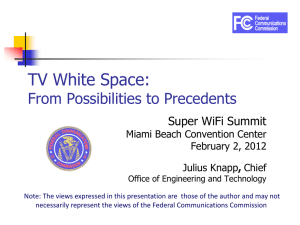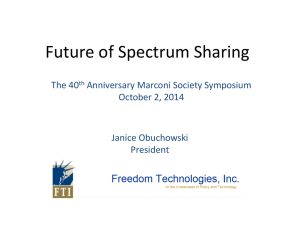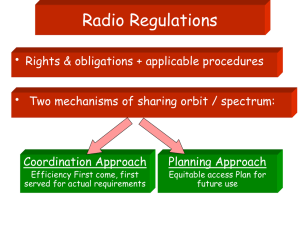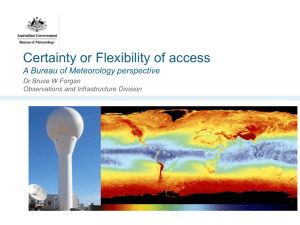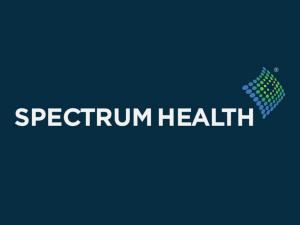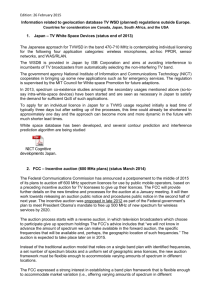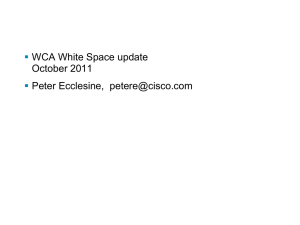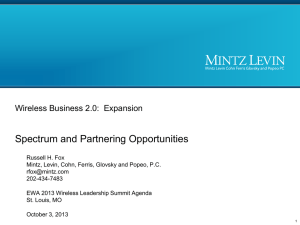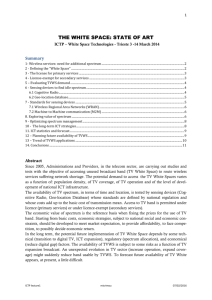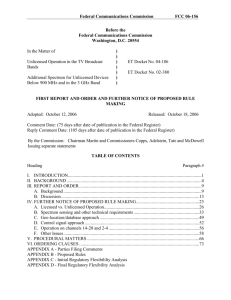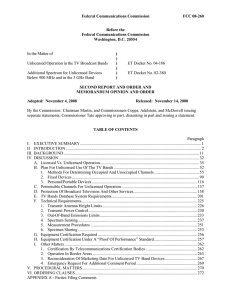Wi-Fi devices
advertisement
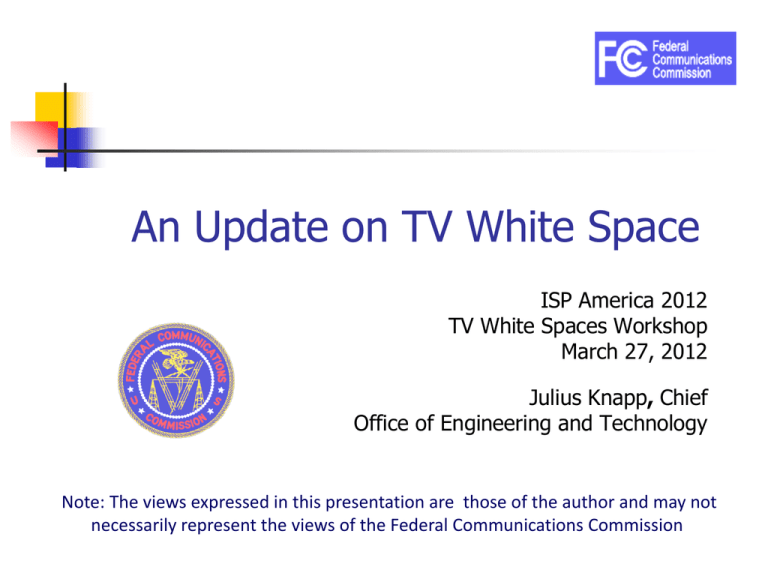
An Update on TV White Space ISP America 2012 TV White Spaces Workshop March 27, 2012 Julius Knapp, Chief Office of Engineering and Technology Note: The views expressed in this presentation are those of the author and may not necessarily represent the views of the Federal Communications Commission Unlicensed Devices: Part 15 Part 15 provides for operation of low power radio transmitters without the need for the user to obtain a license Operating conditions: Minimizes likelihood of interference by: Identifying permissible frequencies Limiting power to very low levels Requiring equipment authorization Permissible frequencies: May not cause harmful interference Must accept any interference received Unlicensed devices are not “allocated” spectrum (except Unlicensed-PCS) Generally operate on unused spectrum or on “overlay” basis Or in ISM “junk bands”: 915 MHz, 2.4 GHz, 5.8 GHz Restricted from operating in public safety & low signal bands Industry has developed voluntary protocol standards within the framework of the rules: Wi-Fi, Bluetooth; Zigbee; etc. Wide Variety of Applications Wi-Fi devices - Home and business networks; hot-spots Community, urban & rural broadband networks by WISPs Bluetooth headsets & keyboards Automobile keyless entry Wireless baby monitors In-home video distribution Remote control toys Toy walkie-talkies Utility meter readers & smart grid energy control Tank level meters Traffic light controls Crane controls Lighting controls & dimmers Wireless door bells Cordless phones Garage door opener controls Sensors for automatic doors Industrial automation controls RF ID systems Retail anti-theft systems Security alarm systems Wireless speakers Satellite Radio-to-FM radio Convergence w licensed devices Medical camera pills Medical panic alerts Meat thermometers Inventory control Pool cover controllers Diaper wetness sensor And the list goes on . . . TV White Spaces • TV channels are “allotted” to cities to serve the local area • Other licensed and unlicensed services are also in TV bands • “White Spaces” are the channels that are “unused” at any given location by licensed devices 2 Low Power TV New York City Full Power TV Stations 5 White Space 7 9 Wireless Microphones Etc. Only for illustrative purposes White Space Philadelphia Full Power TV Stations NonBroadcast spectrum 4 3 Low Power TV NonBroadcast spectrum White Space 6 White Space 8 10 Wireless Microphones Etc. TVWS Spectrum Availability Available spectrum varies by location In rural areas many channels are available In big cities only a few channels may be available Examples of availability in UHF channels 21 – 51 (Illustrative) : 2 1 2 2 New York 2 3 2 4 2 5 2 6 2 2 7 8 2 9 3 0 3 1 3 3 2 3 3 4 3 5 3 6 3 7 3 8 3 9 4 0 4 1 4 2 4 3 4 4 4 5 4 6 4 7 4 8 4 9 5 0 5 1 4 0 4 1 4 2 4 3 4 4 4 5 4 6 4 7 4 8 4 9 5 0 5 1 Washington, DC 2 1 2 2 2 3 2 4 2 5 2 6 2 7 Full Service DTV Station 2 8 2 9 3 0 3 1 3 2 3 3 3 4 Low Power TV Station 3 5 3 6 3 7 3 8 3 9 Channel Open/ Adjacent to TV Channel Open/ Not Adjacent to TV In less dense areas many channels are available. For example: Wilmington, NC: 25 channels = 150 MHz Harrisburg, PA: 19 channels = 114 MHz 5 TV White Spaces Final rules adopted Sept. 2010: Provides first new spectrum for unlicensed below 5 GHz in many years Introduces new spectrum access model based on geolocation & data base of protected services Also allows for spectrum sensing w/ rigorous review & authorization process Services protected in the data base: TV digital and analog Class A, low power, translator & booster stations Broadcast auxiliary (wireless mikes) Cable head-ends and TV translators Land mobile Sites with significant wireless microphone use Data Base Mode 1: Portable device obtains location/channels from fixed device Mode 2: Portable device uses its own geolocation/data base access capability 6 What We’ve Done Jan. 26, 2011, the Commission’s Office of Engineering and Technology issued an Order in ET Docket 04-186, DA 11-131 that conditionally designated TVWS Data Base Administrators: Comsearch, Frequency Finder Inc., Google Inc., KB Enterprises LLC and LS Telcom, Key Bridge Global LLC, Neustar Inc., Spectrum Bridge Inc., Telcordia Technologies, and WSdb; later added Microsoft March – May 2011 held 3 public workshops plus additional meetings & dialogue Extensive info at: http://transition.fcc.gov/oet/whitespace/ Sept. 14, 2011: Announced 1st TVWS data base test - Spectrum Bridge Dec. 2, 2011: Announced 2nd TVWS data base test - Telcordia Dec. 22, 2011: Approved first data base administrator - Spectrum Bridge Dec. 22, 2011: Approved first TVWS device – Koos Technical Services, Inc. (KTS) Jan. 26, 2012: First commercial deployment - Wilmington, NC March 26, 2012: Approved second data base administrator - Telcordia What We Are Doing Accepting & processing applications for equipment certification Continuing process to approve data base administrators Delivery of wireless microphone registration process Waivers to register certain TV receive sites in data base Pending Petitions for Recon. Five parties filed petitions for reconsideration Main issues: HAAT limit of 76 meters Out-of-band emissions Protection of wireless services on TV ch. 52 New class of TV band devices Confidentiality off data base information Decision anticipated soon Benefits of TV White Space Prime spectrum New IEEE 802.22™ standard: Great propagation & coverage High amounts in much of the USA Close to spectrum used by commercial wireless services - - potential synergy IEEE SA Emerging Technology of the Year Award Broadband wireless access over a large area up to 100 km Up to 29 Mbps per TV channel Can increase data rate through use of multiple channels Wi-Fi & TV White Space is not an either-or proposition: Each may suit particular needs Wi-Fi has greater bandwidth but usage density is increasing When combined consumers & users could see significant benefits Potential Applications Provides a new opportunity for innovation and delivery of service, with potential for both research and commercial applications Spectrum is open to everyone & and is available now Broadband (generally) M2M Smart Grid Rural broadband Health Care Video – Monitoring, surveillance, distribution Education State & Local Data traffic off-load Governments Potential uses limited only by the imagination TV Broadcast Incentive Auctions Middle Class Tax Relief and Job Creation Act of 2012 provides for TV incentive auction Incentive auction would share auction proceeds with the current occupant to motivate voluntary relocation of incumbents Broadcaster participation in incentive auction is voluntary in exchange for a share of auction proceeds a broadcaster could: Contribute one or more 6 MHz channels Choose to move from U to V Share spectrum with another broadcaster Or choose not to participate! The FCC Would Need to Realign the Spectrum After the Auction Adjacent Channel Interference FCC would realign the spectrum into blocks to maximize efficiency and value Without realignment, interference between television and wireless operations would increase The FCC would work with industry to minimize any interference or coverage impacts of realignment, as we did for the DTV transition Stations keep current channel numbers Moves to a lower band would be voluntary based on broadcaster reserve price TV BB TV BB TV TV Without Realignment: Reduced Broadband Bandwidth Adjacent Channel Interference TV TV TV TV BB With Realignment: Accommodates Increased Broadband Bandwidth Impact on TV White Space Guard bands and unlicensed use: FCC may implement band plans with guard bands Guard bands shall be no larger than is technically reasonable to prevent harmful interference between licensed services outside the guard bands May permit use of guard bands for unlicensed Unlicensed use shall rely on a data base or subsequent methodology as determined by the Commission There will be white space – size of guard bands & remaining TVWS TBD through rule making Note: The act also calls for NTIA study & FCC rule making to provide more 5 GHz spectrum for unlicensed FCC Notice of Inquiry on Dynamic Spectrum Access (ET Docket 10-237) Notice of Inquiry (NOI) considers how dynamic access radios and techniques can provide a more intensive and efficient use of spectrum Seeks comment on the current state of the art and how FCC can promote these technologies - - test-beds or modifying its spectrum management practices and policies Covers both licensed services and unlicensed devices What spectrum bands would be most suitable? Asks whether TV White Space model might be used for other bands Asks whether and how to incorporate spectrum sensing for other bands Asks whether FCC provisions for secondary market arrangements could be enhanced to increase use by dynamic access radios Asks how to improve FCC “Spectrum Dashboard” for DSA 15 Conclusion Questions?
